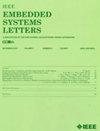SpiKernel: A Kernel Size Exploration Methodology for Improving Accuracy of the Embedded Spiking Neural Network Systems
IF 2
4区 计算机科学
Q3 COMPUTER SCIENCE, HARDWARE & ARCHITECTURE
引用次数: 0
Abstract
Spiking neural networks (SNNs) can offer ultralow power/energy consumption for machine learning-based application tasks due to their sparse spike-based operations. Currently, most of the SNN architectures need a significantly larger model size to achieve higher accuracy, which is not suitable for resource-constrained embedded applications. Therefore, developing SNNs that can achieve high accuracy with acceptable memory footprint is highly needed. Toward this, we propose SpiKernel, a novel methodology that improves the accuracy of SNNs through kernel size exploration. Its key steps include: 1) investigating the impact of different kernel sizes on the accuracy; 2) devising new sets of kernel sizes; 3) generating SNN architectures using neural architecture search based on the selected kernel sizes; and 4) analyzing the accuracy-memory tradeoffs for SNN model selection. The experimental results show that our SpiKernel achieves higher accuracy than state-of-the-art works (i.e., 93.24% for CIFAR10, 70.84% for CIFAR100, and 62% for TinyImageNet) with less than 10 M parameters and up toSpiKernel:一种用于提高嵌入式尖峰神经网络系统精度的核尺寸探索方法
尖峰神经网络(SNNs)由于其基于尖峰的稀疏操作,可以为基于机器学习的应用任务提供超低的功耗/能耗。目前,大多数SNN架构需要更大的模型尺寸来实现更高的精度,这并不适合资源受限的嵌入式应用。因此,开发能够在可接受的内存占用下实现高精度的snn是非常必要的。为此,我们提出了SpiKernel,这是一种通过核大小探索提高snn准确性的新方法。其关键步骤包括:1)研究不同核大小对准确率的影响;2)设计新的内核大小集;3)基于选择的核大小,使用神经结构搜索生成SNN结构;4)分析SNN模型选择的精度和记忆权衡。实验结果表明,SpiKernel在参数小于10 M的情况下,达到了比现有算法更高的准确率(CIFAR10的准确率为93.24%,CIFAR100的准确率为70.84%,TinyImageNet的准确率为62%),搜索时间加速高达4.8倍,适用于嵌入式应用。
本文章由计算机程序翻译,如有差异,请以英文原文为准。
求助全文
约1分钟内获得全文
求助全文
来源期刊

IEEE Embedded Systems Letters
Engineering-Control and Systems Engineering
CiteScore
3.30
自引率
0.00%
发文量
65
期刊介绍:
The IEEE Embedded Systems Letters (ESL), provides a forum for rapid dissemination of latest technical advances in embedded systems and related areas in embedded software. The emphasis is on models, methods, and tools that ensure secure, correct, efficient and robust design of embedded systems and their applications.
 求助内容:
求助内容: 应助结果提醒方式:
应助结果提醒方式:


